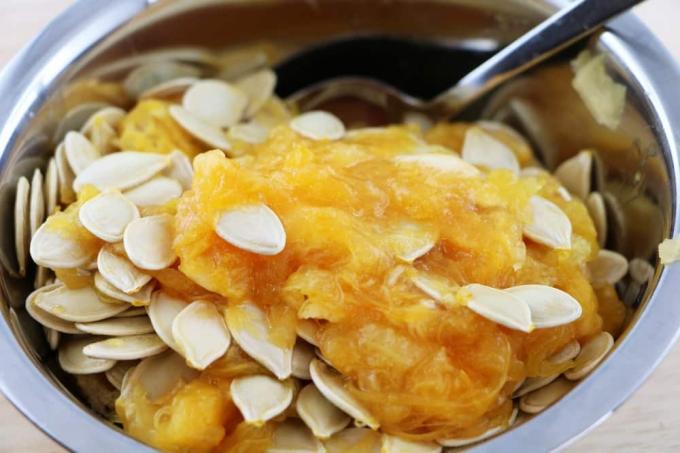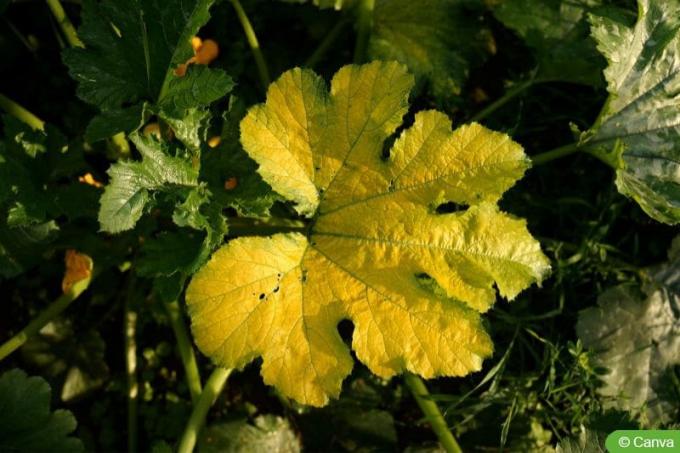

Table of contents
- Dry pumpkin seeds
- location claims
- Preculture in the pot
- Sowing outdoors
- harvest
- Conclusion
- Worth knowing about pumpkin seeds shortly
- sowing
- plant out
- harvest
In autumn they are back in the vegetable displays of the shops, the tasty pumpkins. There are around 700 varieties, and if you want to know what's on the table, you can sow the seeds yourself in spring to get a rich pumpkin harvest in autumn. In this way, every hobby gardener can dry the pumpkin seeds after harvest and use them for new sowing. Of course, snacking on pumpkin seeds is also allowed here, because they are not only tasty but also healthy.
Dry pumpkin seeds
If a pumpkin is eaten in autumn, then the hobby gardener should already be thinking about next year. The pumpkin seeds are not used in food and are usually disposed of. But if you dry them over the winter, you will have wonderful seeds next spring, which can bring a rich harvest of pumpkins in the fall. When drying, proceed as follows:
- Separate the pumpkin seeds from the remaining pulp that can be used for cooking
- remove as much as possible the fibers that hold the kernels together
- then put in a warm, dry place to dry
- a warm south-facing window sill or a warm cellar, preferably the boiler room, are ideal for this
- a dry storage can also be used for the pumpkin seeds
- make sure that the pumpkin seeds are not "stacked" on top of each other but are spread out so they can dry faster
- an oven tray can be used for this
- If there is no convenient place to dry, the kernels can also be placed in the oven at around 60° C for a longer period of time, for example overnight, which will speed things up
- after drying put the seeds in paper bags (no plastic) and keep in a dry place until sowing
Tip:
If you want to snack on the dried pumpkin seeds, you can do so without any danger. The seeds taste even better after drying, lightly roasted in a pan and sprinkled with salt. Since one pumpkin produces many seeds, not all of them have to be used for sowing, but can also be eaten.
location claims
Before sowing, the hobby gardener must find the right place for his pumpkin patch. Because all types of pumpkin, including zucchini, need a lot of space to spread close to the ground. Pumpkins are ground crawlers, which do not form their shoots upwards but along the ground. The other claims of the pumpkin plants to the ideal location are as follows:
- bright and sunny
- well fertilized with compost
- little water, otherwise the shoots and leaves may rot
- a minimum distance of about two square meters around the individual plants is ideal
- The size of the required bed can be calculated according to the number of plants you want later
Tip:
Spread dried grass on the ground around the pumpkin plants! On the one hand, this prevents water from being lost too quickly on warm days, and the soil can store it better. On the other hand, weeds have no chance to grow between the pumpkin plants.
Preculture in the pot
Sowing the pumpkin seeds in pots has the advantage that this can be done regardless of the weather, as the pots can be placed in a warm place to germinate. So they can be sown as early as February. When sowing in a pot, proceed as follows:
- Mix potting soil with some sand and place in small pots and place two to three pumpkin seeds in each pot
- water little
- put in a warm, bright place
- about 20 to 25 °C are ideal for germination
- the seeds begin to germinate, move to a cooler but bright place
- plant the seedlings outside in the bed after the ice saints in May
Tip:
If the hobby gardener wants to know before sowing his seeds whether they are germinable, there is a simple test for this. The dried pumpkin seeds are placed in cold water for about 6 to 7 hours. The seeds that rise to the surface can be used because they are viable. There is no need to sow the remaining seeds.
Sowing outdoors
The pumpkin seeds can also be sown directly in the bed. The ideal time for this is late April. The bed should be covered with foil so that the seedlings do not suffer frost damage during the Ice Saint period. Otherwise the following should be noted:
- prepare the soil with compost and sand for better permeability
- Plant pumpkin seeds about 15 mm deep in the soil
- to avoid frost damage throughout the harvest, the seeds can also be planted at different depths in the ground
- this way, the deeper-seated seeds survive a frosty day better, but also start to germinate and develop later
- stretch a plastic film over the sowing, which protects against too much moisture, especially in a cold, rainy spring
- water only in very dry periods
- Remove the foil in May after the ice saints so that the seedlings can develop better.
Tip:
If the seeds are planted at different heights in the soil and there is no frost damage, the autumn harvest will be longer. The reason: the plants grow at different speeds.
harvest

Pumpkins are usually ready for harvest at the same time as autumn. If the first small, still tender fruits are harvested in summer, they can be used to bring tasty dishes to the table. Later in the fall, when all the pumpkins have grown, they are harvested. But the ripe fruits have a firm skin and do not have to be eaten immediately after harvest. They can therefore be stored in a dry, dark, not too warm place, such as a cellar, for later consumption until well into the winter. The pumpkin flesh can also be frozen for later use.
Tip:
If you have planted many plants, you can harvest the pumpkin blossoms in summer. They are also very tasty and can be found in many dishes, especially in Greek cuisine.
Conclusion
Anyone who has bought a pumpkin in a store to use it should not throw away the pumpkin seeds. These can be dried and sown again in your own garden next spring. Drying, sowing and caring for the pumpkin plants is relatively easy and can also be done by inexperienced hobby gardeners. So if you have enough space in your garden, you can sow many different varieties of pumpkins in spring and enjoy a rich harvest from summer until well into autumn.
Worth knowing about pumpkin seeds shortly
sowing
- It is well known that pumpkins are an autumn plant. So the seeds are sown at the beginning of the year.
- It is important to know here that pumpkin seeds need a lot of heat to germinate.
- To pre-cultivate them, they should be sown in small pots of soil in April and left at around 20°C.
- It takes about a week for the first germs to appear.
- After three to four weeks, the seedlings should be big enough to move to larger, individual pots.
- Only when there is no more frost can the seedlings be planted outside.
- The seedlings should be transplanted outside by mid-June at the latest.
- If they are suspended even later, there are only minimal returns.
- If the pumpkins are to be sown directly outdoors, this should be done in early to mid-May, after the frost period.
- However, this is quite risky if it should get frosty again.
- When sowing, make sure that the pointed side of the pumpkin seed is pointing downwards, because this is where the root will sprout.
- In addition, the seeds should not be placed too deep in the ground. About 1.5 cm should be sufficient.
- Since pumpkins grow very large, the seeds need an appropriate distance from each other.
- Although there are differences in tendrils between individual species, one to two square meters should be planned per plant.
Tip:
Incidentally, the seeds here are so-called oilseeds (similar to the sunflower). This means that the seeds are good for sowing for about five years. Older seeds will often germinate more irregularly and produce poorer yields.
plant out
- As soon as the seedlings are large enough and the weather remains consistently frost-free, they are transferred to the garden or to the chosen field.
- Here you should make sure that the plants have enough space, because vegetable pumpkins in particular are very large and heavy plants.
- Pumpkins grow very quickly, so you can soon see flowering on the more or less large tendrils.
- The flowers of the pumpkins are very large and yellow in color. They also like to be swarmed by bumblebees and bees.
- By the way, snails love pumpkins, so you should ensure adequate protection against snails.
- The soil for a pumpkin planting should always be heavy. Incidentally, compost heaps are very suitable for planting pumpkins on them.
- In dry periods, the pumpkin plants should be watered so that there are good yields.
- If you don't have a compost heap available, you will have to fertilize the pumpkins later.
- In principle, your own compost is sufficient, but special fertilizers are also commercially available.
harvest
- Depending on the time of sowing, the first pumpkins can be harvested as early as the end of August.
- In general, the pumpkins should be harvested between September and November, i.e. before the first frost.
- You can tell if a squash is ready to harvest or not by its bright color and woody stem.
- If you're still not sure whether the pumpkin is ripe, just knock on it: If you hear a hollow sound, the pumpkin is fully ripe.
 garden editorial
garden editorial I write about everything that interests me in my garden.
Learn more about pumpkins

Zucchini fruits rot on the plant: what to do?
Sometimes a young zucchini fruit suddenly stops growing. At the same time it becomes yellow and rotten from the top. Read here how you can save your harvest if the fruits of your zucchini are rotting on the plant.

Harvesting butternut squash: when is it ripe?
Rich yellow flesh and a pear-like shape characterize the butternut squash. If you have enough space for the fast-growing plants, you will be rewarded with many tasty fruits. When is the butternut squash ready for harvest?

Yellow leaves on zucchini: what to do?
Zucchini planted in the garden usually develop so luxuriantly that there is often a veritable glut of zucchini. However, if the zucchini gets yellow leaves, you should consider location, care and diseases as causes and act immediately.

Zucchini: remove male flowers?
Zucchini form female and male flowers on one plant. The male flowers are important for pollination and thus fruit formation. The question often arises as to what the advantages and disadvantages are after removing the flowers.

15 good neighbors of pumpkin | mixed culture
The cultivation of pumpkins is effectively supported by the right mixed culture. Good neighbors protect against pests, can be used as a natural climbing aid and optimize the nutrient balance in the bed. Pumpkins can be cultivated much more successfully this way.

Grow your own luffa cucumber 9 tips for the sponge gourd
Although the luffa cucumber comes from the tropics, it can also be grown locally. However, the sponge gourd is dependent on certain conditions when it comes to location and care, with these tips you will have a rich harvest.



